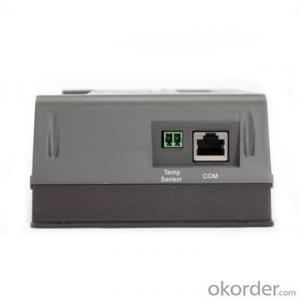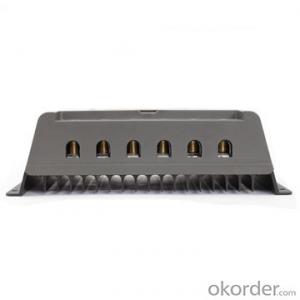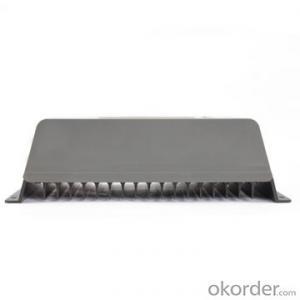LCD/LED High Quality PWM Solar System Charge Controller/Regulator with CE ROHS,45A 12V/24V ,VS4524BN
OKorder Service Pledge
OKorder Financial Service
You Might Also Like
Features:
·Excellent EMC design
·32 bit MCU with high speed
·High efficient Series PWM charging
·Four battery type options: Sealed, Gel, Flooded, and USER
·Intelligent lighting and timer control for solar lighting system
·12 bit A/D high-precision sampling to ensure accuracy
·Use MOSFET as electronic switch
·Full control parameters setting and modification, diversified load control mode
·Humanized design of browser interface, undertake every operating conveniently
·Temperature compensation
·Adopt graphics dot-matrix LCD screen and HMI (human-machine interface) with 4 buttons,integrated menu displaying and operation
·Energy statistics function
·RS485 ports with MODBUS communication protocol
·Optional PC monitoring software and remote meter for real-time monitoring and battery management parameter setting
·Field upgradable firmware
Electronic Protections:
·PV short circuit protection
·PV reverse polarity protection
·Battery overcharge protection
·Battery over discharge protection
·Battery reverse polarity protection
·Load overload protection
·Load short circuit protection
·Overheating protection
Specification:
Model | VS1024BN | VS2024BN | VS3024BN | VS4524BN | VS6024BN |
Nominal system voltage | 12V/24V auto work | ||||
Rated battery current | 10A | 20A | 30A | 45A | 60A |
Rated load current | 10A | 20A | 30A | 45A | 60A |
Max. battery voltage | 32V | ||||
Equalize charging voltage | Sealed: 14.6V, Flooded: 14.8V, User-defined: 9~17V | ||||
Boost charging voltage | Gel: 14.2V, Sealed: 14.6V, Flooded: 14.8V, User-defined: 9~17V | ||||
Float charging voltage | Gel /Sealed /Flooded: 13.8V, User-defined: 9~17V | ||||
Low voltage reconnect voltage | Gel /Sealed /Flooded: 12.6V, User-defined: 9~17V | ||||
Low voltage disconnect voltage | Gel /Sealed /Flooded: 11.1V, User-defined: 9~17V | ||||
Self-consumption | ≤15mA(12V); ≤10mA(24V); ≤9mA(36V); ≤8mA(48V) | ||||
Grounding | Common negative | ||||
Temp. compensation | -3mV/°C/2V | ||||
Relative humidity | 10%~90% Non-condensation | ||||
Communication | RS485 / RJ45 interface | ||||
LCD temperature | -20°C ~ +70°C | ||||
Working temperature | -25°C ~ +55°C | ||||
Humidity | ≤95% N.C. | ||||
Enclosure | IP30 | ||||
Overall dimension | 162x85x40mm | 162x100x50mm | 200x103x58mm | 201x109x59mm | 205x129x67mm |
Terminals | 4mm2 | 10mm2 | 16mm2 | 35mm2 | 35mm2 |
Net weight | 0.2kg | 0.4kg | 0.7kg | 0.9kg | 1.3kg |
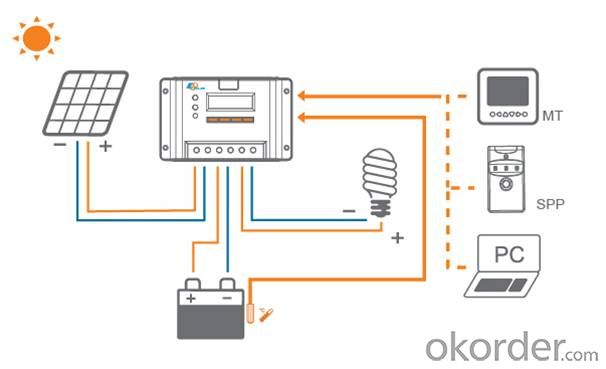

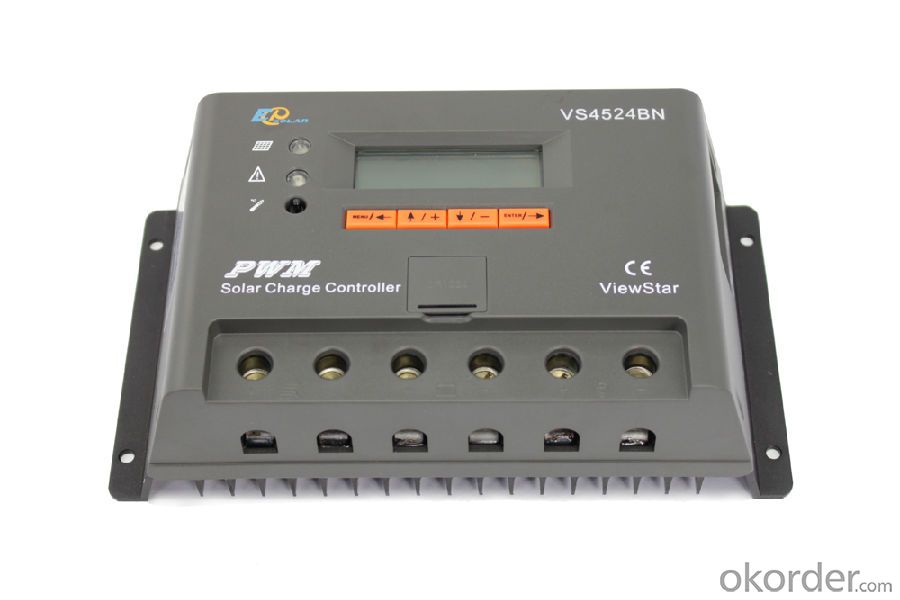

FAQ:
Q1. What is the voltage?
A1. Our 45/60A solar charge controller is 12/24/36/48V auto work.
Q2. What is the difference between MPPT&PWM?
A2. MPPT has higher efficiency, it can track the max power point and won't waste energy.
Q3. What is the efficiency of the MPPT controller?
A3. MPPT>99%, peak conversion efficiency>98%.
Q4. What is the waranty of product?
A4. 12 months.
Q5. What protection does your MPPT controller have?
A5. PV array short circuit, PV reverse polarity, Battery reverse polarity, Over charging, Output short circuit.
- Q:Can a solar controller be used with different types of batteries?
- Yes, a solar controller can be used with different types of batteries as long as the controller is compatible with the specific battery chemistry. However, it is important to ensure that the voltage and charging parameters of the solar controller are suitable for the type of battery being used to prevent damage or inefficient charging.
- Q:What is the display type of a solar controller?
- The display type of a solar controller typically consists of an LCD (Liquid Crystal Display) screen.
- Q:What is the maximum voltage drop allowed in the system by a solar controller?
- The maximum voltage drop allowed in a system by a solar controller depends on the specific controller's specifications and requirements. It is essential to consult the manufacturer's guidelines or documentation to determine the exact maximum voltage drop allowed for that particular solar controller.
- Q:Can a solar controller be used with a solar water pump?
- Yes, a solar controller can be used with a solar water pump. The solar controller helps regulate the power output from the solar panels and ensures that the pump receives the optimal amount of energy for its operation. It helps maximize the efficiency and performance of the solar water pump system.
- Q:What is the difference between a PWM and MPPT solar controller?
- A PWM (Pulse Width Modulation) solar controller regulates the voltage output of a solar panel by rapidly switching the panel's output on and off. This results in a fixed voltage output, which may not be optimal for charging batteries or maximizing power output. On the other hand, an MPPT (Maximum Power Point Tracking) solar controller continuously adjusts the voltage and current to find the optimal operating point, known as the maximum power point (MPP), of the solar panel. This allows for higher power conversion efficiency, especially in conditions where the solar panel's output voltage is different from the battery's voltage. In summary, while a PWM controller regulates voltage through on-off switching, an MPPT controller dynamically adjusts voltage and current to maximize power output from the solar panel.
- Q:What is the maximum load power a solar controller can handle?
- The maximum load power a solar controller can handle depends on the specific model and its design specifications. Generally, solar controllers are designed to handle a range of load powers, typically up to several hundred watts. However, it is crucial to consult the manufacturer's specifications or user manual to determine the maximum load power capacity of a particular solar controller.
- Q:Can a solar controller be used in a grid-tied solar power system?
- No, a solar controller cannot be used in a grid-tied solar power system. In a grid-tied system, the solar panels are connected directly to the utility grid, and the system relies on an inverter to convert the DC power from the panels into AC power that can be used by the home or business. A solar controller is used in off-grid systems to regulate and manage the charging of batteries, which are used to store excess solar energy.
- Q:What is the role of a remote monitoring system in a solar controller?
- The role of a remote monitoring system in a solar controller is to collect and analyze data from the controller, panels, and other components of the solar system. It allows for real-time monitoring of the system's performance and provides important information on energy production, battery status, and any potential issues or malfunctions. This enables remote troubleshooting, efficient maintenance, and optimization of the solar system's efficiency and overall performance.
- Q:Can a solar controller be used with a solar-powered charging station for mobile devices?
- Yes, a solar controller can be used with a solar-powered charging station for mobile devices. The solar controller helps regulate the voltage and current from the solar panels, ensuring a stable and efficient charging process for the mobile devices connected to the charging station.
- Q:What is the maximum power that a solar controller can handle?
- The maximum power that a solar controller can handle varies depending on the specific model and brand. Generally, they are designed to handle a range of power outputs, typically from a few watts to several kilowatts. It is important to consult the specifications provided by the manufacturer to determine the maximum power capacity of a particular solar controller.
1. Manufacturer Overview |
|
|---|---|
| Location | |
| Year Established | |
| Annual Output Value | |
| Main Markets | |
| Company Certifications | |
2. Manufacturer Certificates |
|
|---|---|
| a) Certification Name | |
| Range | |
| Reference | |
| Validity Period | |
3. Manufacturer Capability |
|
|---|---|
| a)Trade Capacity | |
| Nearest Port | |
| Export Percentage | |
| No.of Employees in Trade Department | |
| Language Spoken: | |
| b)Factory Information | |
| Factory Size: | |
| No. of Production Lines | |
| Contract Manufacturing | |
| Product Price Range | |
Send your message to us
LCD/LED High Quality PWM Solar System Charge Controller/Regulator with CE ROHS,45A 12V/24V ,VS4524BN
OKorder Service Pledge
OKorder Financial Service
Similar products
New products
Hot products
Hot Searches
Related keywords

